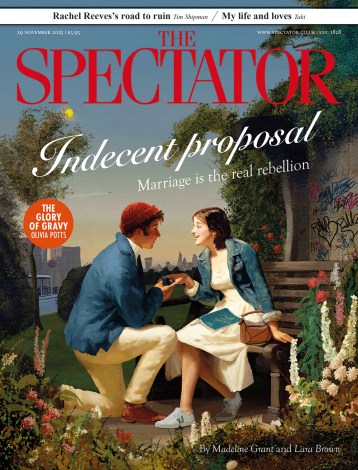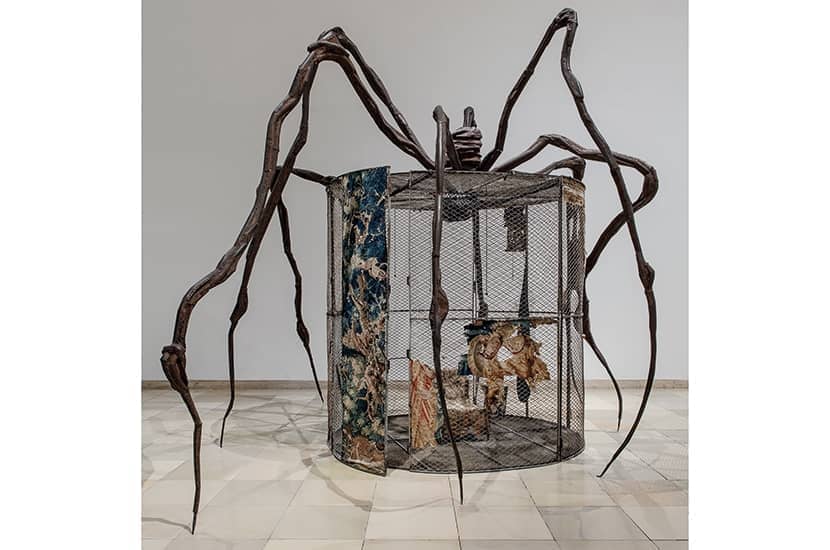Louise Bourgeois was 62 and recently widowed when she first used soft materials in her installation ‘The Destruction of the Father’ (1974). The father in question was not her American late husband Robert Goldwater, the father of her children, but her own French father Louis Bourgeois, long deceased. Set in a space evoking the interior of a digestive tract, the installation’s centrepiece was a table bearing the remains of an imagined feast at which Louise and her brother had eaten their dominating father after dismembering him and cutting off his penis.
You have been warned. There is nothing soft about Bourgeois’s soft sculptures, though — on the evidence of the Hayward’s new exhibition of her late textile works —they did soften with age. In her eighties this extraordinarily tenacious artist, still working until the week before her death in 2010 aged 98, returned to the material she had first handled as a child in her parents’ Parisian tapestry restoration workshop, where she was given the task of redrawing the feet worn away at the bottom of antique tapestries. Her industrious mother ran the workshop in a Paris suburb, while her cheating father fronted the gallery in the Boulevard Saint-Germain and conducted a succession of affairs, including with his daughter’s young English tutor. Bourgeois kept this childhood trauma to herself and her psychotherapist until at the ripe age of 70, to coincide with her first retrospective at MoMA, she spilled her guts in, of all places, Artforum.
The young Louise dreamed of wringing her tutor’s neck while wringing out wet tapestries
For a male artist this could have been career-ending, but the art world loves a woman with a traumatic history. Although self-confessedly therapeutic, Bourgeois’s art is not confessional: unlike Frida Kahlo’s or Tracey Emin’s, it’s not all about her. It does, however, enshrine a lot of personal memorabilia: in ‘Cell XXV (The View of the World of the Jealous Wife)’ (2001), frocks from her past are mounted on dressmaker’s dummies; in ‘Untitled’ (1996), old items of lingerie are suspended on cow bones from a metal frame reminiscent of a drip stand. Several exhibits are literally hung. ‘Spiral Woman’ (2003), made of stuffed and twisted black cloth —the young Louise dreamed of wringing her tutor’s neck while wringing out wet tapestries — hangs from the ceiling, and a headless figure, ‘Single I’ (1996), swallow-dives down the stairwell. ‘My early work is the fear of falling. Later on, it became the art of falling. How to fall without hurting yourself. Later on, it is the art of hanging in there,’ Bourgeois explained.
Other soft humanoid forms recline. A tormented pink head of the artist’s late brother ‘Pierre’ (1998), who died in an asylum, lies on its side, a thing of shreds and patches. Pudgy black headless couples lie together with limbs encased in surgical braces, and a bulbous black female form, all breasts and buttocks, performs an act of obeisance in steel stiletto heels. It sounds kinky but it isn’t; there’s none of the fetishistic frisson of Dorothea Tanning’s earlier soft sculptures of the 1960s. Bourgeois is no surrealist. The woman who claimed, ‘The subject of pain is the business I’m in’ was not playing around. Her distorted bodies and heads with screaming holes for mouths have more in common with the paintings of Francis Bacon, soft-toy alternatives to his churning, gurning paint. Both artists like pink. Bourgeois’s copulating couples may be cuddlier, but her hanging forms recall Bacon’s animal carcasses. Her childhood home was opposite a slaughterhouse.
In the place of Bacon’s space frames Bourgeois has vitrines. I have a problem with contemporary art in vitrines, with its self-aggrandising claim to museum-worthiness. Blame Damien Hirst. But I’m equally unconvinced by the Tardis-like ‘Cells’ Bourgeois knocked up from old wardrobe doors and rusted steel mesh to house personal memorabilia on her time travels. They smell of must and Little Old Lady Land. Even the show’s pièce de resistance, the giant ‘Spider’ (1997) with a cell in its grip, feels hokey — part-gothic horror, part-Acorn Antiques. I half-expected Mrs Overall to totter in with a tea tray.
Bourgeois’s spiders are not meant to alarm us. In the 1990s she began using them to symbolise her weaver mother, always busy trying to repair things, whether Aubusson tapestries or family relationships. ‘My best friend was my mother and she was deliberate, clever, patient, soothing, reasonable, dainty, subtle, indispensible, neat and useful as an araignée [spider].’ Bourgeois lost her when she was 20.
All women of that generation could sew; they were also cast as the peacemakers of the family. In her final body of work Bourgeois celebrated ‘the magic power of the needle… to repair the damage’ and make the broken whole. Her most touching tributes to her mother are the mini-patchworks she pieced together from mattress ticking in her mid-1990s to form patterns of interconnecting spider’s webs. Souvenirs are best kept small.






Comments